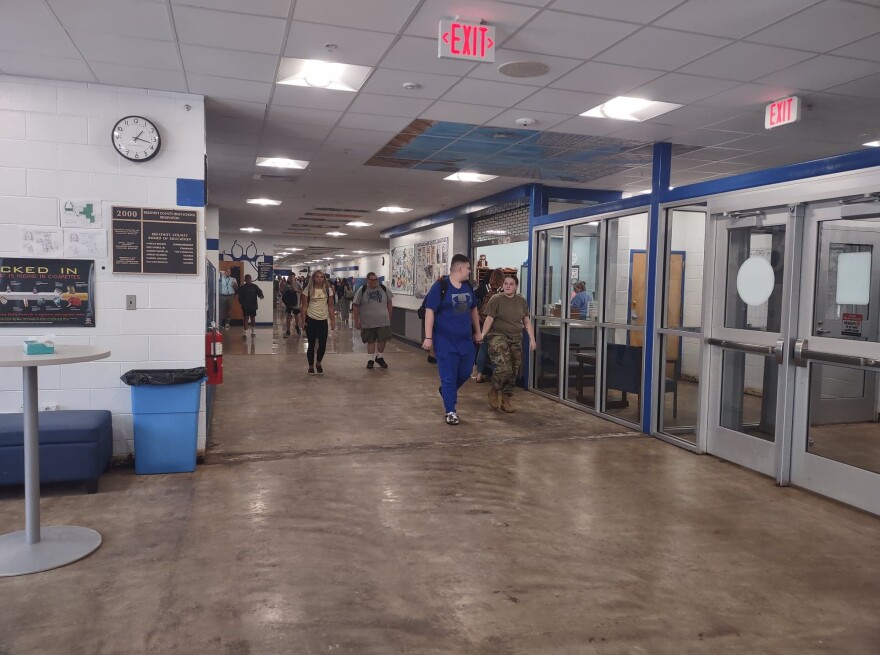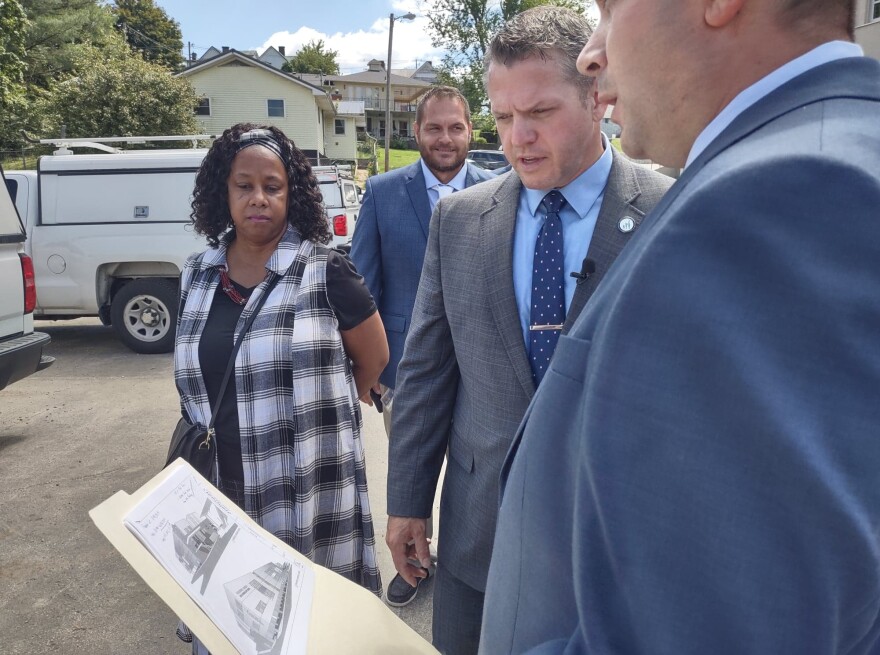Education officials from the state and federal government were in eastern Kentucky last week to survey flood damage and find out what support schools need going forward. They began in Letcher, Knott and Perry counties, where some of the worst impacts of the flooding were felt. The last stop on their trip was Breathitt County.
Officials put up a blue banner to welcome visitors to the Breathitt County Board of Education and schools’ campus. Superintendent Phillip Watts began by thanking his staff who were lined up to greet them.
“These folks are rock stars, they work late, they come in early, they work weekends, whatever it takes for our kids. So, let’s just ah, let’s give all of my staff a big hand,” said Watts.
Education Commissioner Jason Glass and officials from the State Board of Education, the U.S. Department of Education, the Federal Emergency Management Agency, and Kentucky Emergency Management went to see the damage caused by the flood in late July.
Superintendent Watts took visitors to the lower level of Breathitt County High School, which had water damage after the flood.

“Well I was going to kind of show them how much water got up here, it kind of climbed up the steps on us that night,” said Watts.
The sounds of construction carried through the hallways, but the school was a flurry of activity with students moving from class to class.
Toni Konz Tatman is Chief Communications Officer for the Kentucky Department of Education. She said for many districts the first concern was finding students after the flooding.
“That’s the first thing you hear, is you know, we’re just still trying to find kids. We’re still trying to find, where are they? You know, because they’re pretty sure their families have gone to Lexington, or they’ve gone to where another family member might be. And so just trying to make that contact with the families and just checking in on them and that process is still going on,” said Tatman.
Tatman said not only are there health and welfare concerns, but school funding from the state is dependent on attendance and enrollment.

Lu Young is Chair of the Kentucky Board of Education. She said in addition to state revenue, schools get money from local property taxes, which could be another issue down the road.
“If the long-term impact of this, hopefully not, but if it were to be that property is devalued in the region and they lose student population, then they have this double whammy impact of lost local property tax revenue as well as loss of state revenue because they’re funded there based on the number of students they have,” said Young.
Young said superintendents in the region are advocating for their districts now, because the picture could be even more bleak in three or four years.
As far as students in classrooms, officials said attendance is lower than it would normally be at the beginning of a new school year. Education Commissioner Jason Glass said schools need the legislature to change the funding model.
“We could shift to something called Average Daily Membership instead of Average Daily Attendance where basically we’re looking at the enrollment day to day to day instead of how many students are actually in attendance,” said Glass.
Glass said another option many states use is a single day count, how many students are in attendance or enrolled on October 1st.
“Both of those are different ways that we could look at counting enrollment versus Average Daily Attendance that would help solve sort of this disruptive problem around having kids out because of flood impacts or COVID,” said Glass.
Throughout the visit to Breathitt County schools, education leaders and officials stressed the need for mental health resources.
Jackson Independent School Superintendent Wayne Sizemore told Commissioner Glass and other officials they’ve organized a support group for teachers and staff at his school.
“If they take that, wonderful, if not we’ll have to back up and punt see what we need to offer, but I think that’s the first step we need to do. So we need support around the mental health, to guide us. That would be very helpful because I know that’s what we’re dealing with,” said Sizemore.
James Lane, Senior Advisor to the U.S. Secretary of Education, said mental health support is available through the Office of Elementary and Secondary Education.
“You know, one of the reasons that we wanted to come from the US department of education is just to let people know that we’re thinking about them and offer them our support and letting them know if there’s any way we can help, we want to bring the resources that we can bring to support the communities right now,” said Lane.
Back at Breathitt County High School, Superintendent Phillip Watts said he feels hopeful about the future after the visit and connections that were made with state and federal education leaders.
“It just creates hope. And hopefully we can find some resources,” said Watts.




